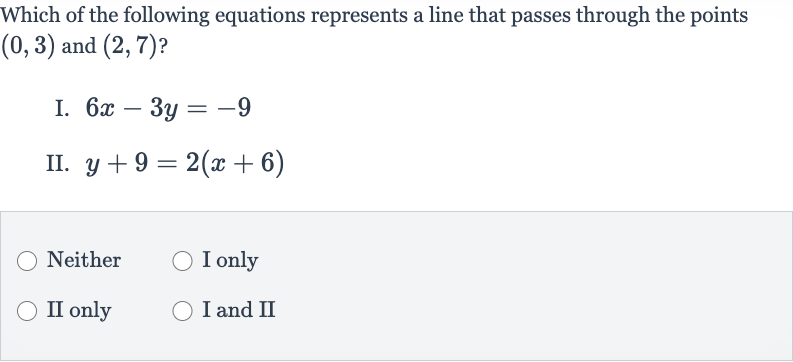Full solution
Q. Which of the following equations represents a line that passes through the points and ?I. II. NeitherI onlyII onlyI and II
- Calculate Slope: First, we need to find the slope of the line that passes through the points and . The slope is calculated using the formula , where and are the coordinates of the two points.
- Use Point-Slope Form: Using the points and , we calculate the slope as follows:.
- Check Equation I: Now that we have the slope, we can use the point-slope form of the equation of a line, which is , to find the equation of the line. We can use either of the two points for this; let's use the point .
- Check Equation II: Substituting the slope and the point into the point-slope form, we get:which simplifies to
- Check Equation II: Substituting the slope and the point into the point-slope form, we get:which simplifies to .Now let's check if equation I, , is equivalent to . We can rearrange equation I to solve for y:
- Check Equation II: Substituting the slope and the point into the point-slope form, we get: which simplifies to .Now let's check if equation I, , is equivalent to . We can rearrange equation I to solve for : Equation I is equivalent to , which means it represents the line that passes through the points and . So, I is a correct equation.
- Check Equation II: Substituting the slope and the point into the point-slope form, we get:which simplifies to .Now let's check if equation I, , is equivalent to . We can rearrange equation I to solve for y:Equation I is equivalent to , which means it represents the line that passes through the points and . So, I is a correct equation.Now let's check equation II, . We can simplify this equation to see if it matches the line :
- Check Equation II: Substituting the slope and the point into the point-slope form, we get:which simplifies to .Now let's check if equation I, , is equivalent to . We can rearrange equation I to solve for y:Equation I is equivalent to , which means it represents the line that passes through the points and . So, I is a correct equation.Now let's check equation II, . We can simplify this equation to see if it matches the line :Equation II is also equivalent to , which means it also represents the line that passes through the points and . So, II is a correct equation as well.
More problems from Write a quadratic function from its x-intercepts and another point
QuestionGet tutor help
QuestionGet tutor help
QuestionGet tutor help
QuestionGet tutor help
QuestionGet tutor help
QuestionGet tutor help
QuestionGet tutor help
QuestionGet tutor help

